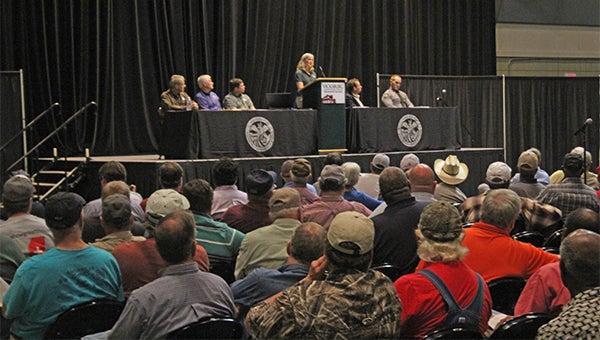Hunters learn about effects, impact of chronic wasting disease from state experts
Published 7:03 pm Tuesday, March 20, 2018
When a deer with Chronic Wasting Disease was found in Issaquena County, right near the edge of Warren County, it was rightfully looked at as a huge cause of concern for the deer population and those who enjoy hunting in the area.
On Monday, the Mississippi Department of Wildlife, Fisheries and Parks held a public meeting at the Vicksburg Convention Center to educate on the disease and help inform the public on how to help control its spread. The panel was made up of people with knowledge of the disease and those who are involved in the efforts to combat it.
Dr. Margaret Wild, a veterinarian for the National Park Service, scientifically broke down this disease, explaining why it was so detrimental to deer and elk populations in certain parts of the United States. She explained that the disease would eventually be fatal in any carriers, although it could take up to 24 months for symptoms to show.
Wild said the symptoms include progressive weight loss, behavioral changes such as lack of awareness, increased drinking, urination and excessive salivation, contact with the latter to being responsible for much of the disease’s spread.
The disease starts in proteins in the central nervous system, but spreads throughout the body and degenerates the brain. The disease is not currently transmittable to humans, but Wild advised exercising caution and not eating any infected animal just to be safe.
Wildlife Bureau Director Russ Walsh said that in the sampling of around 200 deer, no other cases have been found, but sampling will continue.
“Once it establishes itself, there is no cure or vaccine,” Walsh said. “The hunting industry is over a $2 billion industry for us, so it possibly could affect that. It’s important for us to be diligent and vigilant on this disease.”
In order to do that, the MDWFP needs to continue their testing and try to find out exactly what they’re dealing with. Due to the incubation period, the diseased deer found in Issaquena County is more likely not an isolated incident, and there are infected deer in Mississippi. Furthermore, genetic testing showed that the infection came from a local source.
“We need to understand the prevalence, how many deer out of 100 have it, and then what is the geographic extent of that, so we can establish a well-defined management zone, so we can begin to manage that zone and enact the regulations that need to be in place,” Walsh said.
There is currently a supplemental feeding ban in the following counties: Claiborne, Hinds, Issaquena, Sharkey, Warren and Yazoo, and there is a deer carcass import ban from areas affected by the disease.
Walsh’s advice for anyone who comes across an infected deer is to report it to mdwfp.com/ or calling 1-800-BE-SMART
“Just please let us know about it, we’ll collect some information and we’ll look into it,” Walsh said.






